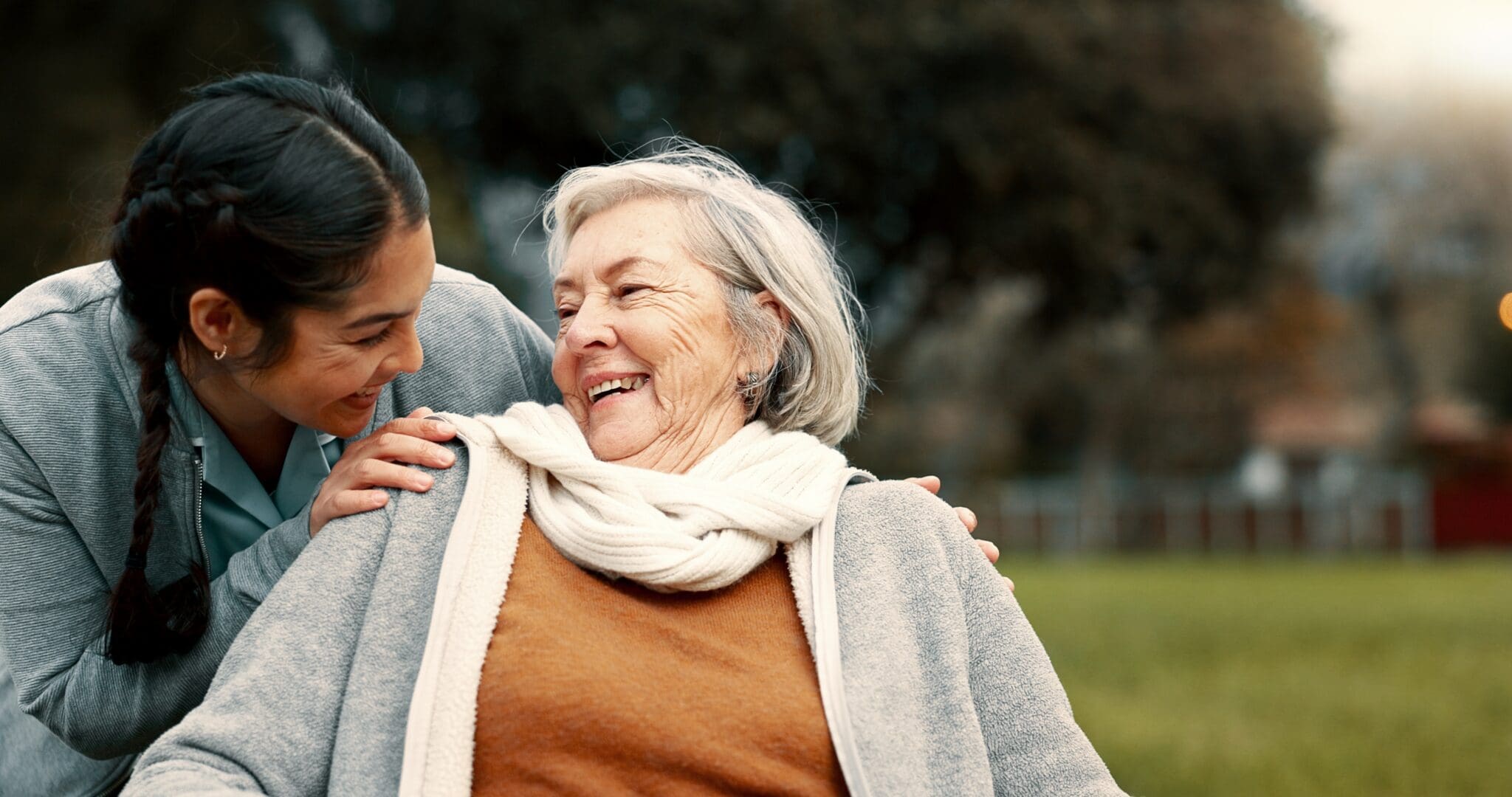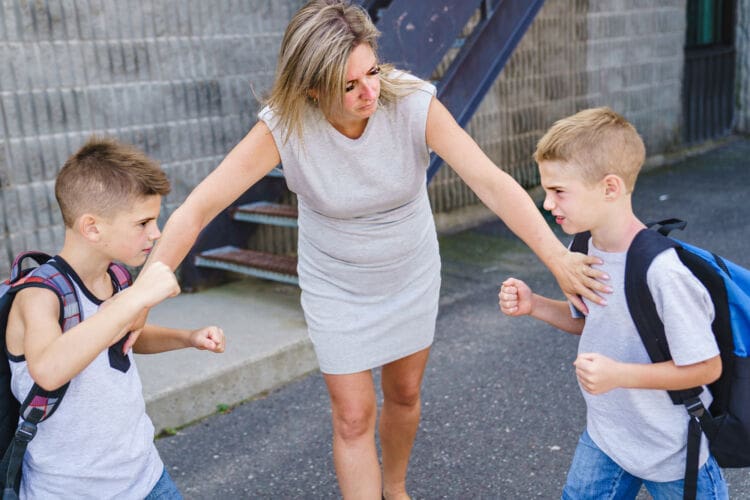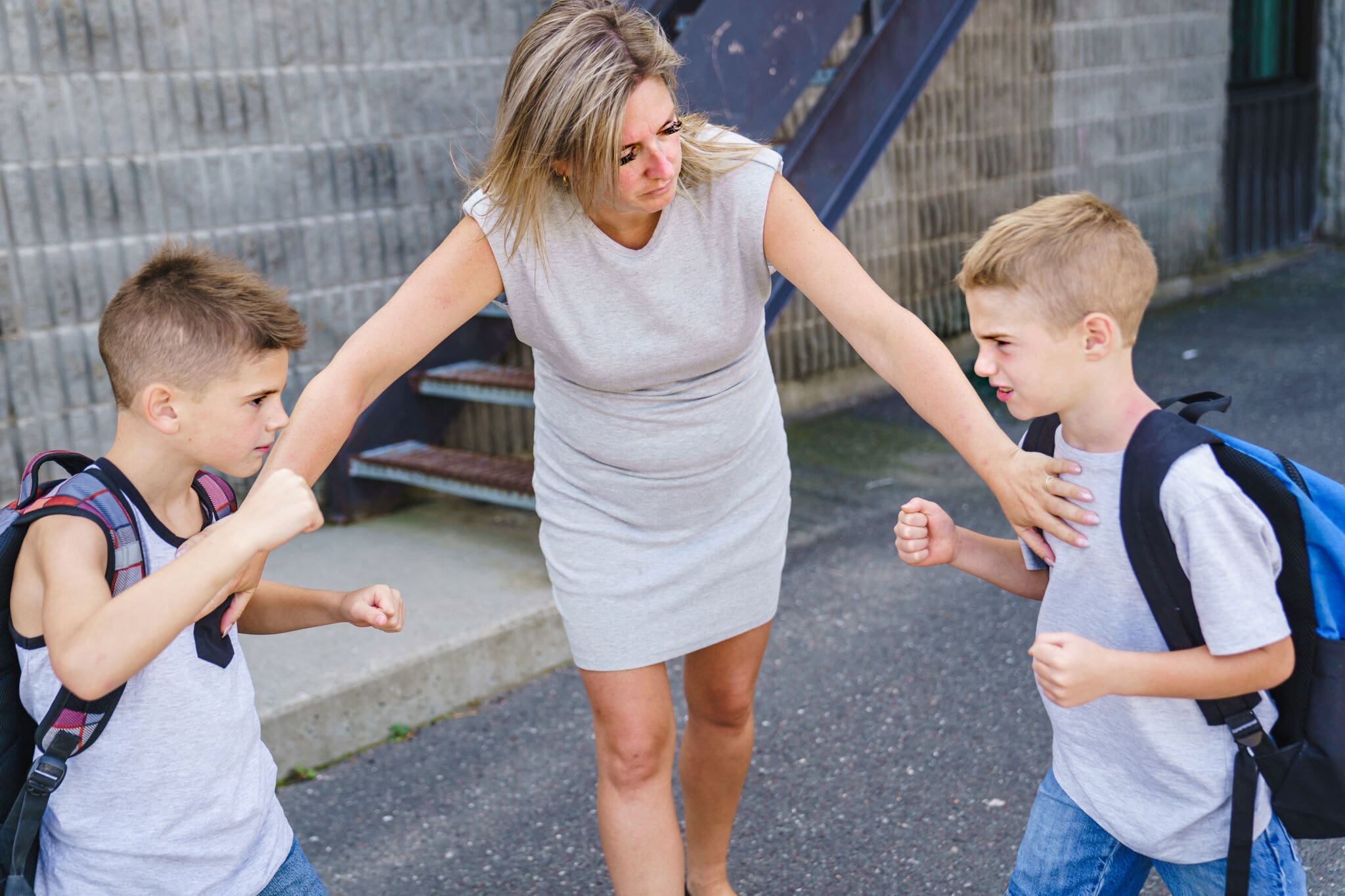In this article
This article guides professionals working in environments where conflict or agitation may occur, such as healthcare, education, social care and security. It will guide you through practical de-escalation skills. You’ll learn to:
- Understand what escalation means and recognise signs
- Communicate calmly, demonstrating empathy and awareness
- Maintain control and self-awareness in challenging moments
- Work within UK legal and ethical frameworks to ensure safety and build trust
What is de-escalation? A working definition
De-escalation is the deliberate process of reducing the intensity of conflict or aggression. It involves using verbal and non-verbal strategies that promote safety, respect and cooperation. It’s a dynamic skillset, underpinned by calm communication, emotional self-regulation and structured interventions designed to prevent situations from spiralling into violence or harm.
In some professional contexts, it’s not uncommon for people to experience heightened stress, distress or agitation. Healthcare, education, social services and security are all good examples. Medical staff, teachers, social workers and security professionals who intervene early with de-escalation techniques can defuse tension and keep people safe.
While each setting has unique pressures, the core principles of de-escalation include:
- Empathy
- Awareness
- Clear communication
It’s easy to assume de-escalation is about passivity or avoidance. But it’s actually an active, intentional approach that requires confidence and adaptability. You can learn to recognise the subtle shifts in emotion and behaviour that signal tension is rising, and to respond in ways that restore a sense of control and collaboration. This often involves moving from an instinctive reaction – like confrontation or withdrawal – towards strategies that:
- Build rapport
- Validate the person’s experience
- Offer constructive alternatives

Why de-escalation matters in high-risk situations
High-risk environments – emergency departments, schools for children with behavioural needs, community outreach in volatile areas or security posts – can be unpredictable. There’s a potential for rapid escalation. A minor misunderstanding can trigger emotional flare-ups, threats to personal safety or even physical violence. Effective de-escalation reduces these risks by interrupting the escalation cycle early, preventing injuries to staff, service users and bystanders, and avoiding costly disruptions such as security interventions or police involvement.
In the UK, many professional sectors must comply with stringent duty-of-care obligations and human rights standards. This means that effective de-escalation is a frontline defence against conflict and a vital component of safe practice. Failing to de-escalate someone who is agitated can breach this duty, exposing organisations to litigation or regulatory sanctions.
The use of restrictive physical interventions, like restraint, is strictly regulated under guidelines like the Mental Health Act Code of Practice and the Use of Force in Care Settings guidance. Effective de-escalation reduces the need for such interventions.
Beyond safety and compliance, de-escalation builds trust and strengthens therapeutic relationships. People are more likely to cooperate with assessments, treatment plans or behavioural programmes when they feel heard, respected and supported. This spirit of collaboration enhances outcomes.
Common triggers and early warning signs
Understanding what sparks escalation is crucial to intervening before conflict intensifies. We can broadly categorise triggers into the following groups:
- Environmental factors – crowded or noisy spaces, perceived lack of privacy, long waiting times or abrupt changes in routine
- Interpersonal dynamics – perceived disrespect, authoritative language, cultural insensitivity or inequitable treatment
- Individual vulnerabilities – past trauma, mental health conditions, physical discomfort or substance use
Early warning signs are the subtle and not-so-subtle signals that tension is rising. They often occur in a sequence, from internal agitation to overt aggression.
- Subtle signs – a rigid posture, clenched fists, rapid breathing, flushed face or neck
- Behavioural cues – pacing, restless shifting, raised voice, talking quickly, terse responses
- Cognitive indicators – fixating on a grievance, repetitive questioning or catastrophic statements (suggesting that the individual is mentally “stuck” in a stress loop)
Recognising these triggers and signs early lets professionals step in with calming communication and adjust the environment before things escalate further. For example, spotting a client starting to rock or speak quickly is a chance to gently redirect the situation, reducing stress for everyone and showing respect for their experience.
The psychology of escalation and aggression
Aggression escalation is a complex mix of neurological, cognitive and social processes.
Biologically, the fight-or-flight response primes the body for immediate action when threatened. This triggers adrenaline, which raises heart rate and muscle tension, focusing attention sharply on perceived danger. While this response helps in real life-threatening situations, it can cause overreactions in everyday conflicts, leading to responses that are out of proportion to the situation.
Cognitively, individuals under stress often experience tunnel vision, focusing on perceived slights or threats and ignoring other perspectives. Confirmation bias strengthens negative interpretations (“They always ignore me”), while emotional reasoning conflates feelings with facts (“I feel angry, so they must intend to harm me”). These distortions fuel the escalation cycle, as each party’s actions are interpreted more negatively, leading to more defensiveness or aggression.
Socially, power dynamics and group influences can amplify aggression. Power differences – such as between student and teacher, patient and nurse or citizen and officer – can provoke resistance or opposition. In group settings, people might take stronger positions to fit in or avoid seeming weak.

Legislative context: Duty of care and use of force
In the UK, professionals’ obligations around de-escalation are supported by a framework of legislation and guidance to protect people and regulate the use of force.
Key legislative and regulatory frameworks include:
- Health and Safety at Work etc. Act 1974 – Employers must ensure safe systems of work, which include training staff in conflict management and de-escalation. Failure to do so may constitute a breach, attracting enforcement action by the Health and Safety Executive or local authorities.
- Mental Health Act 1983 (as amended) – Requires that any restrictive intervention be a last resort, proportionate and the least restrictive option available. The accompanying Code of Practice stresses de-escalation as the primary response to aggression in mental health settings.
- Mental Capacity Act 2005 – Any decisions or interventions must respect the individual’s autonomy and use restraint only when necessary to prevent harm.
- Education Act 1996 and related regulations – Reasonable force is permitted to prevent pupils from harming themselves or others, but only after all positive handling and de-escalation strategies have been tried. Staff must be trained and incidents documented.
- The College of Policing Authorised Professional Practice – Sets out specific de-escalation protocols, emphasising dialogue, empathy and proportionality. Officers are expected to use a range of tactical communication techniques before resorting to physical control measures.
Across all these sectors, robust record-keeping and incident analysis support accountability and continuous improvement.
Non-verbal communication: Posture, space and movement
Effective de-escalation depends a lot on non-verbal cues that communicate calm, respect and attentiveness. These can be improved through three core components: posture, use of personal space and controlled movement.
Posture
A relaxed, open posture – shoulders level, arms uncrossed and feet angled slightly towards the person – signals approachability and non-threat.
Leaning in just a little shows engagement without appearing threatening. It’s important to avoid looming or overpowering stances that might intimidate. Maintaining a balanced distance allows both parties to feel comfortable and free to move, helping prevent feelings of being trapped.
Personal space
Respecting the other person’s space is crucial. Proximity that feels “too close” can trigger defensive responses, while too much distance may seem detached or dismissive.
A general guideline is to stand at least an arm’s length away, adjusting based on the person’s comfort and cultural norms. Invading space can be counterproductive; instead, use a seated position or diagonal approach to create a more relaxed atmosphere.
Movement
Purposeful, slow movements reassure the other person that there’s no threat of sudden aggression. Quick or abrupt gestures can be misinterpreted as hostile.
When moving around the environment – such as fetching paperwork or a glass of water – it’s helpful to explain these actions out loud to maintain transparency.
Subtly mirroring the individual’s hand gestures or breathing rhythm can also create a subconscious connection, showing empathy and shared calmness.
Active listening and reflective responses
Active listening is about truly tuning in and showing that you understand another person’s feelings and experiences. It’s not about just hearing the words but interpreting emotions, summarising key points and responding in a way that shows you’re really paying attention.
Practitioners should maintain eye contact, nod where appropriate and use gentle prompts like “I see” or “Tell me more”. When someone expresses frustration or anger, the listener can reflect back by paraphrasing: “It sounds like you’re upset because your concerns haven’t been addressed.” This is a reflective response that confirms the speaker is being heard and helps clarify their specific issues.
Acknowledging emotions by naming feelings – like saying “I can appreciate that this situation feels overwhelming” – validates the person’s perspective without necessarily endorsing an aggressive stance. This reduces defensiveness and encourages collaboration. Avoiding judgmental language and resisting the urge to jump into problem-solving mode also gives the person space to feel safe and truly express their underlying concerns.
Tone of voice and verbal techniques
The tone of voice is a powerful yet subtle tool in de-escalation. Speaking with a calm, measured pitch and moderate volume helps convey reassurance and control. It’s important to avoid raising the voice, sounding flat or monotone, or making sudden loud noises that might startle the person.
Using “I” statements rather than “you” accusations helps to minimise blame. For example, “I’m concerned about your safety” feels less confrontational than “You need to calm down.” Open-ended questions – like “What’s most important to you right now?” – encourage conversation, while closed questions can feel restrictive. Offering clear choices, such as “Would you prefer to sit over here or walk outside?” restores a sense of autonomy and eases power struggles.
Language should be simple and direct, avoiding jargon or complicated instructions that may overwhelm. When giving directions, break them into single steps and check for understanding: “First, let us sit here. Then, we can discuss what happened.” This structured approach makes the situation feel more predictable and manageable.
Being aware of your own emotions during escalation
Effective de-escalation starts with managing your own personal emotions and physical responses.
Techniques such as controlled breathing – inhale for four seconds, hold for two, exhale for six – help slow heart rate and reduce tension. Grounding exercises, like focusing on the sensation of your feet on the floor, can anchor attention and prevent impulsive reactions.
Being aware of personal triggers is equally important as it enables practitioners to anticipate and mitigate their own emotional reactions. These might be certain words, displays of aggression or stressors. Supervision, peer support and reflective practice provide safe spaces to process difficult situations and build resilience.
Where emotional contagion occurs – where you are drawn into the individual’s heightened emotional state – it can be helpful to ask for support. For example, you might call a colleague to observe or replace the lead communicator.
The importance of empathy and respect
Empathy is the capacity to understand and share another person’s feelings. It’s fundamental to building trust and facilitating cooperation.
Simply acknowledging emotions isn’t enough to demonstrate real empathy. You’ll also need to show you genuinely care about the person’s well-being. Phrases such as “I can see this is very distressing for you” or “You’re not alone in this” foster connection and reduce isolation.
Respect for personal dignity is essential in all interactions. Using the person’s preferred name, speaking without a patronising tone and honouring their cultural or identity needs shows genuine care. Being mindful of different cultural customs (consider things like eye contact or personal space) helps build trust and avoid misunderstandings.
When empathy is paired with respect, it reminds people they are valued as individuals, not just “problems” to solve. This warm, human-centred approach helps ease tension and opens the door to cooperation and understanding.

De-escalation in schools and youth settings
In educational environments, de-escalation needs to fit each child’s developmental stage and the school’s ethos. Teachers and support staff trained in trauma-informed practice recognise that challenging behaviour often signals unmet needs or previous adverse experiences.
Since young people may struggle to articulate their emotions, visual aids – such as emotion wheels or “zones of regulation” charts – can help facilitate self-expression.
Schools using positive behaviour support (PBS) frameworks focus on proactive strategies:
- Setting clear expectations
- Consistent routines
- Positive reinforcement
When tension arises, practitioners can use “take-up time” – pauses after giving instructions – to allow pupils to process and respond without feeling rushed.
Restorative approaches prioritise repairing relationships over punishments with:
- Circle processes (where participants sit in a circle and take turns speaking)
- Peer mediation
- Collaborative problem-solving
These methods empower students to voice grievances and negotiate solutions. De-escalation is embedded throughout the curriculum, with social and emotional learning (SEL) lessons equipping young people with the self-regulation skills needed to prevent conflicts from escalating.
Healthcare and mental health environments
Healthcare and mental health settings present unique challenges. People may be experiencing distress due to pain, fear, confusion or psychiatric symptoms.
Approaches like the Safewards model promote specific interventions – such as using gentle language, mutual help meetings and calm rooms – to reduce conflict and minimise coercion on wards.
In community mental health teams, clinicians use de-escalation to:
- Build a therapeutic alliance
- Manage crises in patients’ homes or public spaces
This work involves balancing the strategic use of the Mental Health Act (to assess capacity and determine care pathways) with respect for autonomy and least-restrictive care principles. Effective de-escalation here reduces admissions, supports rapid crisis resolution and enhances long-term engagement with services.
Public services and lone worker scenarios
Lone workers – such as social workers, outreach officers or security guards – often operate in unpredictable environments without immediate backup, making de-escalation incredibly important.
De-escalation training for these roles focuses on:
- Situational awareness
- Risk assessment
- Emergency communication plans
Making use of technologies like personal safety alarms, GPS-enabled check-in apps and covert duress signals is also helpful as they back up personal skills to ensure help can be called in quickly if needed.
In public services, multi-agency collaboration strengthens de-escalation. Joint training exercises involving police, paramedics and social care staff help develop a shared language, clarify roles and coordinate responses to high-risk incidents, such as welfare checks in volatile households. By working together and debriefing after incidents, professionals build mutual trust and ensure de-escalation strategies are consistent across sectors.
Recording and reporting incidents
Accurate documentation is key to accountability and continuous learning. Incident reports should capture a factual account of events, including triggers, warning signs, interventions used and outcomes.
Structured formats – such as the SBAR (situation, background, assessment, recommendation) approach – ensure clarity and facilitate information sharing across teams.
Reflective logs encourage practitioners to think about what worked well, what could have been done differently and any systemic factors contributing to escalation. Looking at incident data across the organisation can reveal patterns – like certain times, locations or triggers – which can then guide improvements to policies, staffing and training.
Transparent reporting also maintains professional standards and supports legal compliance.
Training and certification options
A wide range of accredited de-escalation and conflict-management courses is available in the UK.
- The Crisis Prevention Institute (CPI) offers internationally recognised training in safe behaviour management.
- ProAct-Scotland, endorsed by the Scottish Government, provides positive approaches to behaviour support in education and care.
- The Restraint Reduction Network delivers evidence-based workshops grounded in human rights and least-restrictive practice.
- MAPA (Management of Actual or Potential Aggression) and Team Teach integrate practical skills for physical intervention as a last resort.
- For security professionals, the British Security Industry Authority (BSIA) mandates conflict management training for licensure under the Security Industry Authority (SIA) licence requirements.
- Mental health staff may pursue de-escalation modules within the Core Skills Training Framework (CSTF), approved by Health Education England.
When selecting a programme, organisations should consider accreditation status, how it aligns with sector-specific guidance and opportunities for refresher training and ongoing supervision.
Embedding de-escalation skills within a broader culture of continuous professional development ensures that staff remain confident and competent in high-pressure situations.
Teamwork and coordinated responses
De-escalation works best when teamwork is strong.
- Clear role definitions – lead communicator, observer, support responder – prevent confusion during an incident.
- Pre-assigned escalation protocols, including when to call for additional resources or invoke emergency procedures, ensure that staff act swiftly and cohesively.
- Regular multi-disciplinary drills familiarise all team members with each other’s methods and reinforce shared language.
- During an incident, effective communication – through discreet hand signals, coded language or radios – allows the team to coordinate movements and interventions without alarming the individual or bystanders.
- Afterwards, collaborative debriefs let everyone share their thoughts. Successes are reinforced, and areas for improvement can be identified. This kind of collective reflection builds resilience, cohesion and a unified approach to future challenges.
Post-incident reflection and support
After any de-escalation, taking time to reflect and offer emotional support is vital for everyone involved. A well-facilitated debrief – ideally within 24 to 48 hours – gives everyone a safe, non-judgemental space to share what happened and look at the sequence of events, what worked well, any unintended effects and practical steps for the future.
Challenging incidents can leave staff feeling drained or unsettled. Access to clinical supervision, peer support or counselling can help ease stress and protect long-term well-being. For the person who experienced the intervention, a follow-up conversation reinforces the care and respect that underpinned the approach, helping to build trust and reduce the risk of future crises.
When reflection and support are part of everyday practice, teams not only strengthen their skills but also show that well-being and learning matter as much as immediate safety. Every experience, whether smooth or difficult, becomes a chance to grow into safer, kinder practice.






